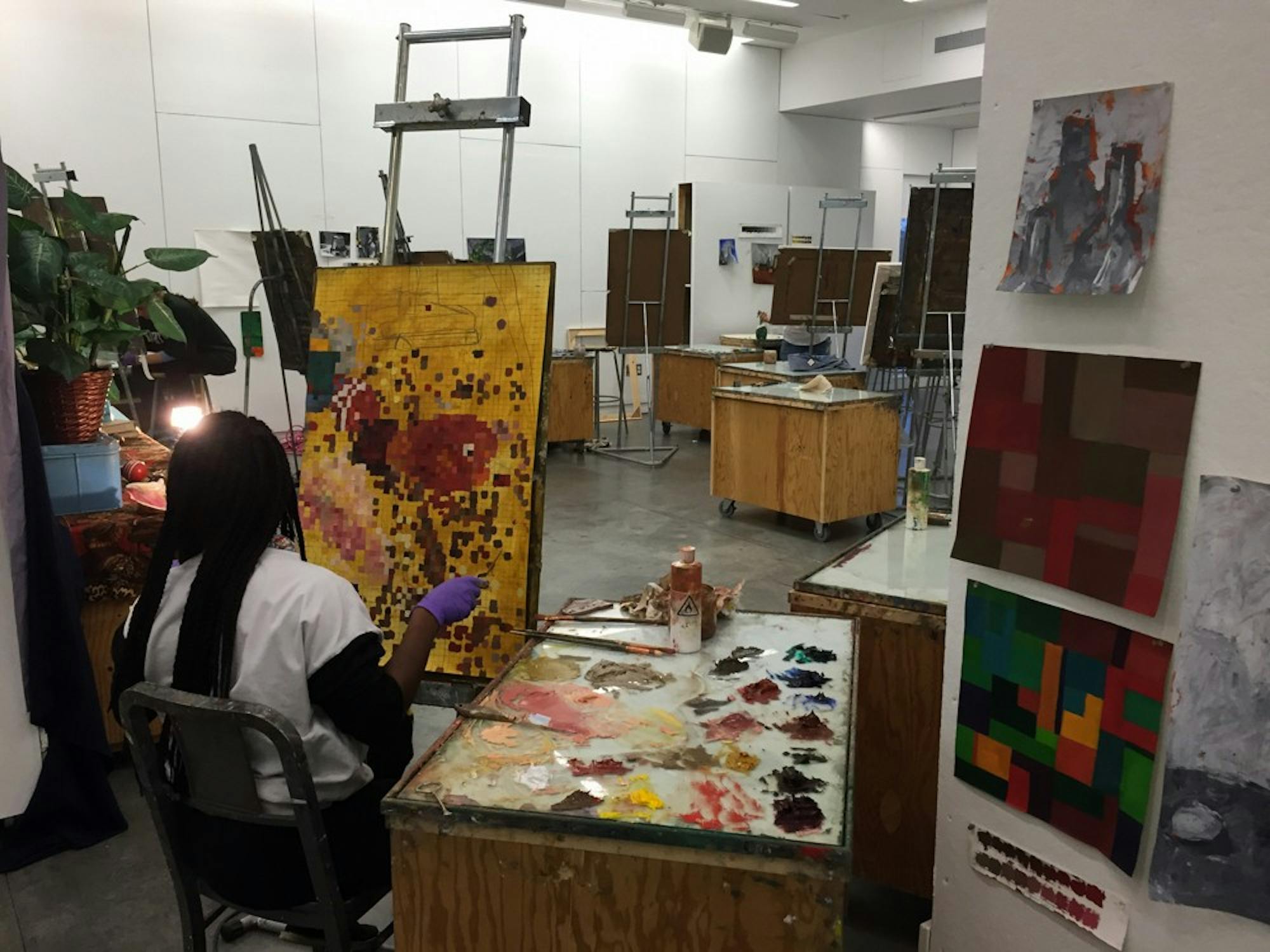Two floors up from the elegantly minimalist lobby of the Black Family Visual Arts Center, the studio art department’s painting studios promise a boldly different aesthetic. Paint of every color splatters the tables and chairs, and the students’ workspaces exhibit their unique artistic styles. A wide array of artificial flowers and fruit crowd a table toward the front of the “Painting I” area, waiting to be arranged for upcoming still-life assignments. Tall white panels create a series of alcoves, each one used by a different student from “Painting I,” “Painting II” or “Painting III” as his or her place of creative refuge for the term.
“This becomes your space,” current studio art intern Gabriel Barrios ’15 said. “This is where you’re developing your own voice.”
The department offers painting classes each term that attract students from every corner of campus.
Adelaida Tamayo ’16, an anthropology major and studio art minor, is currently enrolled in “Painting III” with professor Colleen Randall. She recalled her experiences in earlier painting courses at Dartmouth and explained that, no matter what her fellow students’ majors or intended career paths may have been, they were all fully dedicated to the creative process.
“Everyone [was] clearly very invested in what they were working on,” Tamayo said.
Students enrolled in painting classes have constant access to the studios and a wealth of resources at their disposal.
“I always have more than I need,” Tamayo said. “It’s insane to see the amount of new materials we get here every single term.”
Studio art professor Enrico Riley explained that a large screen projection system is also in place for class use.
“The studios are wired for audio-visual, which is really helpful,” Riley said.
Riley went on to recall the overcrowded painting studios that were used prior to the construction of the BVAC, which opened its doors to the public in 2012. He commented that in comparison the new studios are “quite amazing.”
Corinne Hardy ’16, a studio art major who has focused on painting throughout her time at Dartmouth, said that she has always appreciated how incredibly supportive Riley and his colleagues are, especially for students that are just starting out.
“One of the most amazing experiences you can have as a professor is seeing your students gain understanding of a medium to the point where they become independent and it becomes theirs,” Riley said.
Hardy has certainly reached that point. This term, she is stationed in the senior studio space working on her pieces for the spring showcase. She will be working for an art and design start-up after graduation.
The department’s painting classes stimulate ongoing artistic and personal growth. Students are encouraged regularly to break out of their comfort zones.
“You get so uncomfortable so quickly,” Barrios said. “Some people also get very vulnerable very quickly, and I think that’s something to embrace. That’s when [students] will get the most out of a class.”
Painting students also form lasting bonds within this challenging creative context.
“We have a lot of work days, so we can just kind of be in the studio and get feedback and see how other people are working too,” Tamayo said. “It’s always fun when it’s filled with other students’ art and we can get inspiration from what they’re doing.”
Barrios echoed her statements, calling the environment “communal.”
All the students agreed that their hard work pays off once they have the chance to step back, appreciate the work they’ve produced and reflect on their artistic progress.
“It’s always just really rewarding at the end of the term,” Hardy explained.
For those looking to get started with painting, Barrios recommends first enrolling in “Drawing I,” the prerequisite for every other studio art course. He also suggests that students remain patient with themselves and follow the valuable guidance offered by professors.
”If you just take a leap of faith and trust what the professors are telling you, you’ll get somewhere pretty quickly,” Barrios said. “[They] are super encouraging and have helped me develop my skills tremendously.”
Barrios concluded by pointing out that classes such as painting, which stray from conventional college pedagogy, are an invaluable experience for students across the board.
“The community [is] just great,” he said. “You get this really wild energy that I think is hard to recreate in more traditionally academic environments.”




